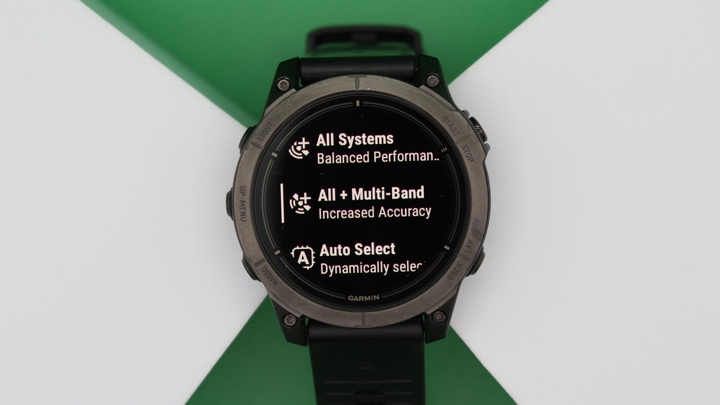
Garmin watches are among the top options for those who want to accurately track their outdoor workouts, but understanding which satellite system and mode to select is anything but easy.
Thanks to a combination of different Global Navigation Satellite Systems (GNSS) being mixed with Garmin's own branding for different tracking modes, there's plenty of jargon to demystify for those trying to find the best tracking for their workouts.
Below, we'll provide the detail behind the acronyms and explain optimal conditions for each unique tracking mode on your Garmin watch.
GNSS systems: Understanding the basics
Wareable
What is GPS?
The Global Positioning System (GPS) is the satellite array you'll likely be most familiar with, as the US government's system becoming synonymous with tracking location for activity.
Almost every Garmin watch released over the last decade is able to access at least GPS, and using it on its own is a great way to save some battery life - even if there are also some sacrifices to this, as well, which we'll discuss below.
What is GLONASS?
Like GPS, GLONASS is another satellite system designed to provide positional information from your Garmin.
The difference between GPS and GLONASS is that the latter is developed and operated by Russia, with receivers also said to pick up a signal 20% quicker than those just using GPS.
A large number of Garmin watches (dating back to the Garmin Fenix 3) are able to pair GPS and GLONASS for a more accurate connection.
What is Galileo?
So we've covered the US and Russia's satellite armadas, but what about Europe? Well, that would be Galileo.
More modern Garmin devices also harness Galileo satellites in conjunction with GPS (instead of GPS + GLONASS), such as the Garmin Fenix 5 and newer.
Understanding Garmin GPS options
Wareable
What is Dual frequency / Multi-Band?
This is where we split off from state-owned satellites and into Garmin's own lingo.
Dual frequency systems - or Multi-Band, as Garmin calls its own solution for this - is essentially a method of tracking that allows for more consistent and accurate positioning in challenging environments.
Employing Multi-Band ensures that the watch tracks more than one signal from each satellite on different frequencies, meaning that environmental interference is mitigated.
- Pro: The Multi-Band + All Systems option provides the best accuracy
- Con: Will drain the battery much quicker than other options
All Systems
Another Garmin term, 'All Systems' refers to the option on the most premium and modern watches to tap into various GNSS.
This means that the device is able to leverage GPS, GLONASS, and Galileo - as well as QZSS (Japan), BeiDou (China) and IRNSS (India) - in order to deliver the most accurate positioning.
Garmin watches that feature All Systems will have the option to use this as a standalone option or combine it with the power of dual frequency / Multi-Band in order to improve accuracy even further.
- Pro: Allows the watch to dynamically switch between the satellites offering the best connection
- Con: A middle-ground option that doesn't offer the best accuracy or the least battery drain
SatIQ / Auto Select
Garmin's SatIQ is the default option on most of its modern outdoor watches, and cleverly determines the optimal mode based on your surroundings.
It's able to determine when Multi-Band may be required (in built-up cities or dense woodland, for example) or when the low-power, standalone GPS can achieve the same accuracy.
Also tagged as 'Auto Select' in some watches, this means you can essentially trust your Garmin watch to pick the best tracking mode for the occasion - providing optimal accuracy is the priority, of course.
- Pro: Ensures the best accuracy without you having to do anything
- Con: Can be prone to the odd hiccup compared to Multi-Band + All Systems
What is UltraTrac?
The option for when you're on the start line of an ultramarathon or extended hike, UltraTrac is the most battery-focused tracking mode available via Garmin.
The GPS data recorded is much less frequent, which means accuracy is likely to be compromised (even when compared to continuous GPS-only tracking).
- Pro: A superb option for multi-day events when battery life is the priority
- Con: Accuracy will be compromised
Which systems does my Garmin support?
Garmin devices that only support GPS
- D2
- D2 Bravo
- Epix
- Fenix
- Fenix 2
- Tactix
Garmin devices that support GPS-only or GPS + GLONASS
- D2 Charlie
- Fenix 3
- Fenix 3 HR
- Fenix Chronos
- Tactix Bravo
Garmin devices that support GPS, GPS + GLONASS and GPS + Galileo
- D2 Delta series
- Descent G1 series
- Descent Mk1 & Mk2 series
- Enduro
- Fenix 5 & 5 Plus series
- Fenix 6 series
- Instinct & Instinct 2 series
- MARQ Collection
- Tactix Charlie
- Tactix Delta series
Garmin devices that support All Systems
- D2 Mach 1
- Enduro 2
- Epix (Gen 2) & Epix Pro (Gen 2) series
- Fenix 7 & 7 Pro series
- Tactix 7 series
How to change Garmin satellite tracking
Wareable
Setting a new default satellite tracking mode is very straightforward, and is the same no matter which mode you want to select. Follow these steps to do so:
1. Hold the 'Up/Menu' button.
2. Scroll down to 'Settings' and select 'Activities & Apps'.
3. Select the activity/app you want to set a new tracking mode for.
4. Select the settings for the activity/app ('Run Settings', for example).
5. Scroll down to 'Satellites' or 'GPS'.
6. Select the tracking mode you want to act as the new default for that activity/app.
How we test
